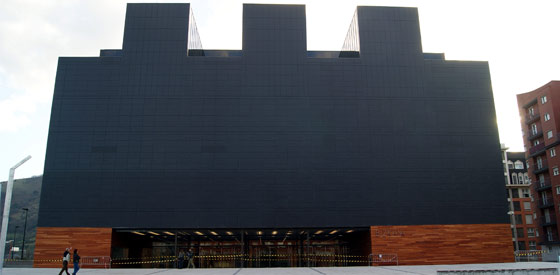 |
Watch or try your hand at the most Basque of sports, pelota (jai alai), at the Bizkaia Frontoia.
(Photo: josu orbe, via Flickr) |
Promenade along the Nervión River for the best glimpses of the city’s latest architectural achievements. Start near the Isozaki Atea, Japanese architect Arata Isozaki’s 21st-century, five-building residential and office complex, a sort of gate to the city that connects the Ensanche area with the river. The complex features twin 23-floor glass towers and a grand staircase reminiscent of Rome’s Spanish Steps. Cross over the waterway via any of several recently added footbridges, such as Santiago Calatrava’s sailboat-inspired glass-and-brick Puente Zubizuri, a tied-arch bridge spanning the right and left banks. Just to the west is the dragonfly-shaped Puente Pedro Arrupe, covered in nonslip Lapacho wood and engineered with an anti-vibration system. Beside the Guggenheim you’ll find the La Salve, a cable bridge with a steel deck that merges with the museum, reflecting off the pools in front of it, and L'arc Rouge, by French artist Daniel Buren, which was erected to celebrate ten years of the Guggenheim and acts as a sort of open door connecting the city center and the museum to the rest of the world.
Wander through the Alhóndiga Bilbao, a Philippe Starck�designed civic center built out of an early 20th-century wine-storage facility that was a longtime eyesore. The city-block-size complex has been sectioned into distinct shopping and entertainment areas, including rotating exhibitions and festivals, not to mention a rooftop pool with a transparent floor that’s open to the public. Be sure to visit Shopa, a funky design and bookshop with vintage and designer furniture (from $105), top-notch Spanish olive oils and wines (from $10.50), and many Philippe Starck products, like a spider-shaped citrus squeezer ($13). Stop at the Hola Bar for a glass of Albariño ($5) in the evenings, and head to the Terraza Club, a kind of distant relative to MoMA’s PS1, for an outdoor patio with edgy DJs, such as Tiga Lilly and Dj2D2, spinning synth-pop tunes.
See the largest pelota (jai alai) court, or frontón, of the Basque Country at the Bizkaia Frontoia, which opened in 2011 and seats 3,000 spectators. The hulking black slate modernist structure is an attraction in and of itself, a sober monument to the sport that looks like a giant Tetris piece beamed in from outer space. It’s also the headquarters of the sport’s various incarnations and the site of the professional pala pelota (hand pelota) championships (note how the black wall used in the game reflects the building’s façade materials). Guided tours ($2) take place every Friday at noon, and if a professional match isn’t up while you’re visiting, demonstrations of the sport can be arranged through the website (from $40).